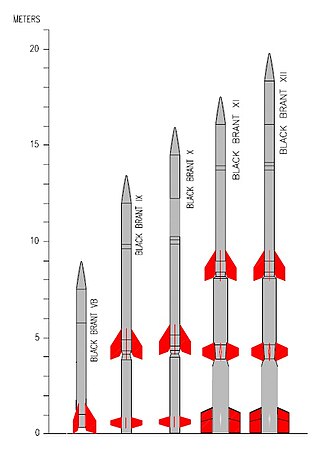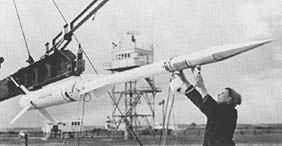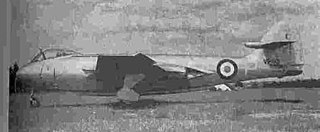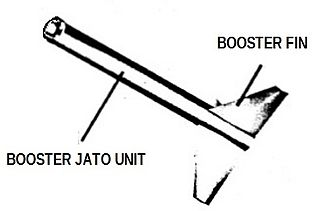

Kappa was a family of solid-fuel Japanese sounding rockets, which were built starting from 1956.


Kappa was a family of solid-fuel Japanese sounding rockets, which were built starting from 1956.
The Rikugun Ki-202 Shūsui-Kai was a direct development of the German Messerschmitt Me 163 Komet rocket-powered interceptor aircraft. None were produced before Japan's surrender that ended World War II.

The Black Brant is a family of Canadian-designed sounding rockets originally built by Bristol Aerospace, since absorbed by Magellan Aerospace in Winnipeg, Manitoba. Over 800 Black Brants of various versions have been launched since they were first produced in 1961, and the type remains one of the most popular sounding rockets. They have been repeatedly used by the Canadian Space Agency and NASA.

The Sikorsky Cypher and Cypher II are types of unmanned aerial vehicles developed by Sikorsky Aircraft. They are vertical takeoff and landing aircraft which use two opposing rotors enclosed in a circular shroud for propulsion.

The Bell X-9 Shrike was a prototype surface-to-air, liquid-fueled guided missile designed by Bell Aircraft as a testbed for the nuclear-armed GAM-63 RASCAL. It is named after the shrike, a family of birds.

Bélier is the designation of a French sounding rocket family. Three versions of the Bélier were launched between 1961 and 1970 at the CIEES launch facility at Hammaguir, the Salto di Quirra and Ile du Levant missile ranges, and Kourou Space Center.
Taurus Orion is the designation of a two-stage sounding rocket, consisting of a Taurus starting stage and an Orion upper stage. The Taurus Orion has a ceiling of 200 km, a takeoff thrust of 457.00 kN, a takeoff weight of 2000 kg, a diameter of 0.58 m and a length of 11.40 m.
Astrobee is the designation of series of American sounding rockets with one to three stages.

Nike Asp was an American sounding rocket. The Nike Asp has a ceiling of 220 km, a takeoff thrust of 217 kN, a takeoff weight of 700 kg, a diameter of 0.42 m and a length of 7.90 m.

Arcas was the designation of an American sounding rocket, developed by the Atlantic Research Corp., Alexandria, Va.

The Hawker P.1072 was a 1949 experimental British aircraft acting as a test bed for the Armstrong Siddeley Snarler rocket booster engine. It was the prototype Hawker Sea Hawk modified to install the rocket in the tail.

The Vultee XA-41 was originally ordered as a dive bomber. After combat experience led the Army Air Corps to believe dive-bombers were too vulnerable to enemy fighters, the contract was amended to change the role to low-level ground attack. Although the XA-41 was a potent weapons system, the design was overtaken by more advanced technology, and never entered production.

The Soko J-20 Kraguj is a light military, single-engine, low-wing single-seat aircraft with a metal airframe, capable of performing close air support, counterinsurgency (COIN), and reconnaissance missions, that was designed by VTI and manufactured by SOKO of Yugoslavia, first flown in 1962.
The Valmet L-80 TP Turbo-Vinha was a prototype for a new Finnish turboprop basic trainer aircraft. The aircraft, which carried the registration OH-VBB, first flew on 12 February 1985. It was destroyed in a crash on 24 April 1985, during its 14th flight, killing the test pilot Paavo Janhunen. The aircraft was a further development of the Valmet L-70 Vinka and would eventually lead to the Valmet L-90 Redigo.

VSB-30 - "Veículo de Sondagem Booster – 30" or "Foguete Suborbital VSB-30" is the designation of a Brazilian sounding rocket, which replaced the Skylark rocket at Esrange.

The Terrier Orion sounding rocket is a combination of the Terrier booster rocket with the Orion rocket used as a second stage. This spin stabilized configuration is most often used by the Goddard Space Flight Center, who operate out of the Wallops Flight Facility for sounding rocket operations. The system supports payloads ranging from 200 to 800 pounds, and is capable of achieving altitudes as high as 120 miles (200 km), but at least 50 miles (80 km), depending on payload size.

The Fieseler Fi 99 Jungtiger was a German sports aircraft prototype, produced by Fieseler company. The aircraft was a low-wing two-seat aircraft with an enclosed cabin. It was powered by a Hirth HM 506A engine, producing 160 hp (119 kW).

The Gotha Go 150 was a light aircraft designed at the German company Gothaer Waggonfabrik in the late 1930s. It was intended for civilian use, but ended up being used as a military trainer.

The Nike stage or Nike booster, a solid fuel rocket motor, was created by Hercules Aerospace for the Nike Ajax (M5) Nike Hercules (M5E1). It was developed for use as the first stage of the Nike Ajax and Nike Hercules missiles as part of Project Nike.
The Deland Travel Air 2000 is an American homebuilt aircraft that was designed and produced by Orlando Helicopter Airways, an aircraft maintenance and repair company located in DeLand, Florida. When it was available the aircraft was supplied as a kit for amateur construction and marketed under the "Deland" brand, named for the company's location. Plans were also available.

The Algol family of solid-fuel rocket stages and boosters is built by Aerojet and used on a variety of launch vehicles. It was developed by Aerojet from the earlier Jupiter Senior and the Navy Polaris programs. Upgrades to the Algol motor occurred from 1960 until the retirement of the Scout launch vehicle in 1994.